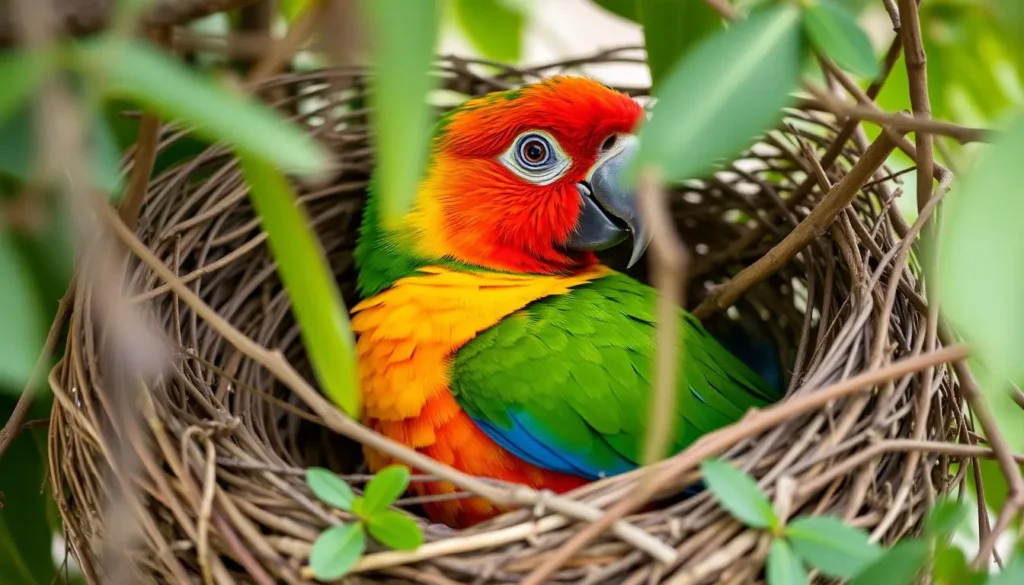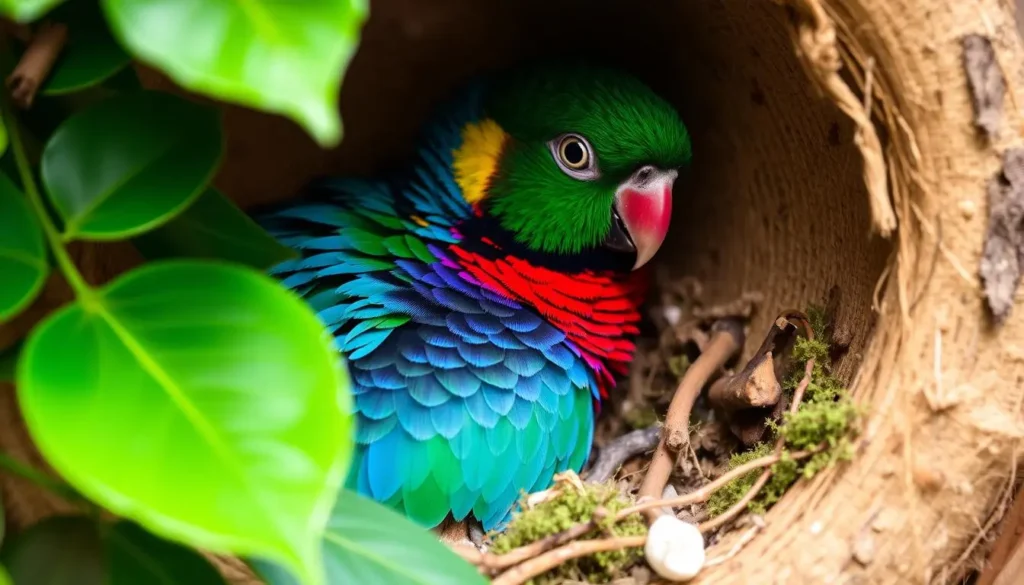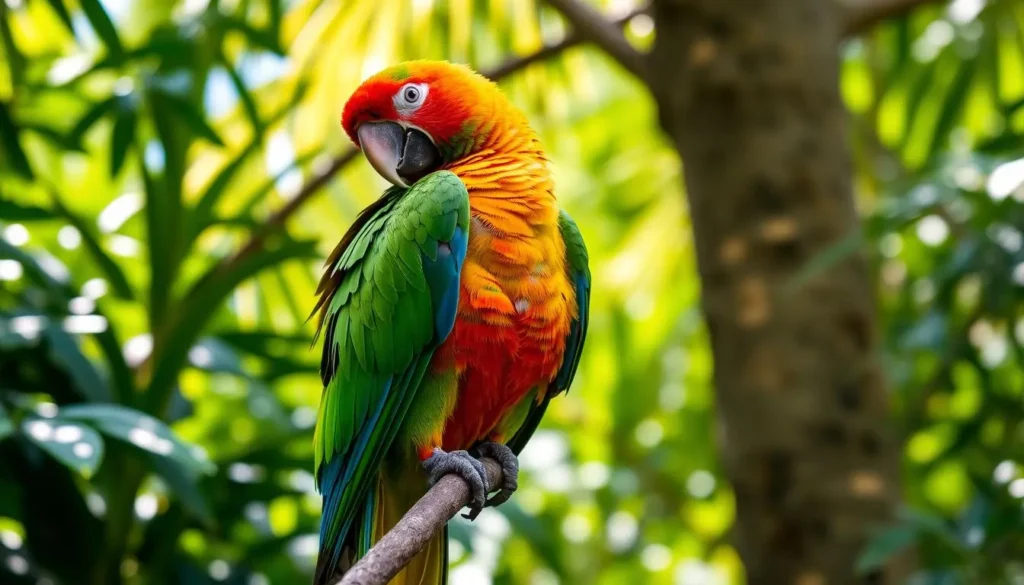Table of Contents
conure parrot nesting with head exposed
If you love birds, you might have seen a conure parrot nesting with its head out. This sight is not only interesting but also teaches us a lot about how birds reproduce. We’ll explore why they do this, how to spot nesting signs, and how to care for your conure during this time.

Key Takeaways
- Conure parrots often nest with their heads exposed, a behavior that is natural and common for the species.
- Understanding the signs of nesting and egg-laying can help you provide the best care and environment for your conure during this critical time.
- Proper nest box setup and minimizing disturbances are key to ensuring a successful nesting experience for your conure parrot.
- Feather plucking and excessive preening may indicate issues during the nesting process, requiring attention and potential veterinary intervention.
- Conure parrot nesting is a fascinating behavior that provides insight into their natural breeding habits and the importance of supporting their needs during this life stage.
Understanding Conure Parrot Nesting Behavior
Conure parrots have a unique way of nesting, often with their heads exposed. This helps them keep an eye on their surroundings and keep the eggs at the right temperature. Knowing how conures nest can help you understand their breeding habits and keep them healthy.
Conure Parrots’ Natural Nesting Habits
Conures like to nest in small, cozy spots like tree holes or nest boxes. These places offer them privacy and safety during nesting and incubation. They use twigs, leaves, and soft stuff to make their nests comfy and warm for their eggs.
Signs of Nesting and Egg-Laying
When conures are getting ready to lay eggs, they act differently. They become more protective of their nest and may fight off anyone who tries to get in. Female conures also spend a lot of time in the nest, getting it ready for their babies. When they lay their heads in the nest, it’s a clear sign they’re nesting.
It’s important to know how conure parrots nest to take good care of them. By spotting the signs of nesting, you can help your conure raise its young successfully.
Conure Parrot Nesting with Head Exposed
One of the most fascinating aspects of conure parrot nesting is how they position their heads outside the nest. This is while incubating their eggs. This unique behavior is believed to serve several important purposes for the parrot behavior of these intelligent birds.
By keeping their heads exposed, conure parrots can better monitor their surroundings for potential threats. This ensures the safety of their nest and hatchlings. Also, this positioning helps them maintain the proper temperature and humidity levels within the nest. These are crucial for the successful incubation of their eggs.
Conure parrots are known for their strong parenting instincts. This conure parrot nesting with head exposed behavior is a testament to their commitment to providing the best possible care for their offspring. Understanding this behavior can help pet owners and breeders better support their conures during the breeding season.
“Conure parrots’ unique nesting behavior, with their heads exposed, reflects their unwavering dedication to ensuring the survival of their young.”
By observing and respecting this natural behavior, we can create an environment that allows conure parrots to thrive during the critical nesting period. This, in turn, can lead to a more successful breeding season. It also ensures the continued well-being of these charming and engaging companion birds.
| Behavior | Purpose |
|---|---|
| Conure Parrot Nesting with Head Exposed | Monitor surroundings for threats Maintain proper temperature and humidity in the nest Reflect strong parenting instincts |
Ensuring a Successful Nesting Experience
To support your conure parrot during nesting, a good environment is key. You need a proper nest box and a quiet, private area. This setup helps your conure feel safe and boosts breeding chances.
Proper Nest Box Setup
The nest box is vital for conure parrot care. Choose a box with these specs:
- Dimensions: About 12 inches wide, 12 inches deep, and 18 inches tall.
- Material: Use sturdy wood or similar materials that can handle the conures’ weight and activity.
- Entrance: A circular opening of 4-5 inches in diameter, near the top.
- Substrate: Use a thin layer of aspen shavings or similar material at the bottom for comfort and insulation.
Providing Privacy and Minimal Disturbances
For a successful aviary setup, a private nesting area is essential. Here’s how to achieve it:
- Put the nest box in a quiet, low-traffic spot in the aviary or enclosure, away from busy areas.
- Reduce human visits and disturbances near the nesting area.
- Make sure the nesting area is protected from direct light and outside noises, offering privacy and seclusion.
By following these tips, you can help your conure parrot have a successful nesting experience. This supports their natural breeding and increases the chances of a healthy brood.

Common Issues During Conure Parrot Nesting
Conure parrots usually do well with nesting, but sometimes problems can occur. Feather plucking and too much preening are common issues. These signs often mean the bird is stressed or uncomfortable.
Feather Plucking and Excessive Preening
Feather plucking and too much preening can be worrying during nesting. These behaviors might be due to:
- Stress or anxiety from changes in their environment
- Boredom or lack of things to do
- Health issues like skin problems or damaged feather follicles
It’s crucial to tackle these issues quickly. If not, they could worsen and harm your bird’s health. Understanding why and acting fast can help your conure parrot nest smoothly.
| Potential Causes of Feather Plucking and Excessive Preening | Recommended Solutions |
|---|---|
| Stress or anxiety | Provide a quiet, private nesting environment with minimal disturbances |
| Boredom or lack of stimulation | Offer toys, puzzles, and other enrichment activities to keep your conure engaged |
| Underlying health issues | Consult an avian veterinarian to rule out any medical problems |
By tackling the reasons behind feather plucking and excessive preening during parrot behavior in nesting, you can ensure a smooth experience for your bird.

Conclusion
Conure parrots have a unique way of nesting, often with their heads exposed. This behavior is interesting and shows how they naturally care for their eggs. By understanding this, you can help your conure during breeding season.
Keep an eye out for signs of stress like feather plucking. Quick action can keep your bird happy and healthy. A well-set up nest box and a quiet space are key for a successful breeding season.
Exploring conure parrot nesting reveals the complex world of bird reproduction. By being informed and caring, you can enjoy a fulfilling experience with your bird. It’s a journey of discovery and connection.
FAQ
Why do conure parrots often expose their heads while nesting?
Conures show their heads while nesting to watch for dangers. They also keep the nest at the right temperature and humidity. This is a natural instinct that helps them during incubation.
What are the signs that a conure is preparing to lay eggs and start nesting?
Signs include more preening and time in the nest box. They might also change how they sound. You might see them collecting nesting materials or being more protective of the area.
How can I set up the perfect nesting environment for my conure?
For a great nest, use a nest box that fits right and has soft bedding. Make sure the area is quiet and safe. This helps your conure feel secure while they breed.
What are some common issues that may arise during conure parrot nesting, and how can I address them?
Feather plucking and too much preening can be stress signs. To fix this, keep the nest calm and add fun activities. This keeps your conure happy and busy while nesting.